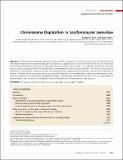Chromosome Duplication in Saccharomyces cerevisiae
Author(s)
Labib, K.; Bell, Stephen P
Download1027.full.pdf (2.356Mb)
PUBLISHER_CC
Publisher with Creative Commons License
Creative Commons Attribution
Terms of use
Metadata
Show full item recordAbstract
The accurate and complete replication of genomic DNA is essential for all life. In eukaryotic cells, the assembly of the multi-enzyme replisomes that perform replication is divided into stages that occur at distinct phases of the cell cycle. Replicative DNA helicases are loaded around origins of DNA replication exclusively during G 1 phase. The loaded helicases are then activated during S phase and associate with the replicative DNA polymerases and other accessory proteins. The function of the resulting replisomes is monitored by checkpoint proteins that protect arrested replisomes and inhibit new initiation when replication is inhibited. The replisome also coordinates nucleosome disassembly, assembly, and the establishment of sister chromatid cohesion. Finally, when two replisomes converge they are disassembled. Studies in Saccharomyces cerevisiae have led the way in our understanding of these processes. Here, we review our increasingly molecular understanding of these events and their regulation. Keywords: DNA replication; cell cycle; chromatin; chromosome duplication; genome stability; YeastBook
Date issued
2016-07Department
Massachusetts Institute of Technology. Department of BiologyJournal
Genetics
Publisher
Genetics Society of America
Citation
Bell, S. P. and K. Labib. “Chromosome Duplication in Saccharomyces Cerevisiae.” Genetics 203, 3 (July 2016): 1027–1067 © 2016 Bell and Labib
Version: Final published version
ISSN
0016-6731